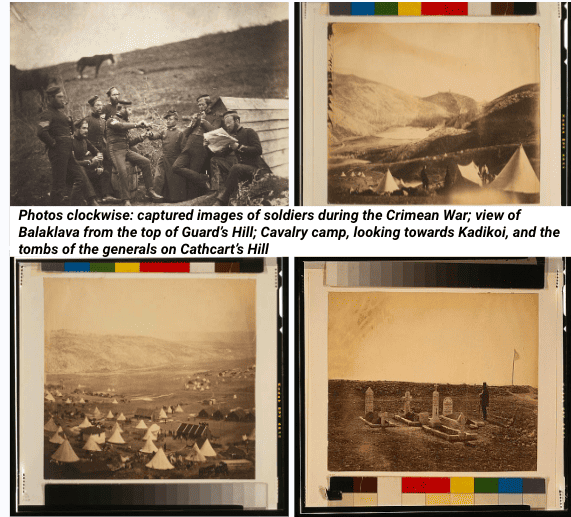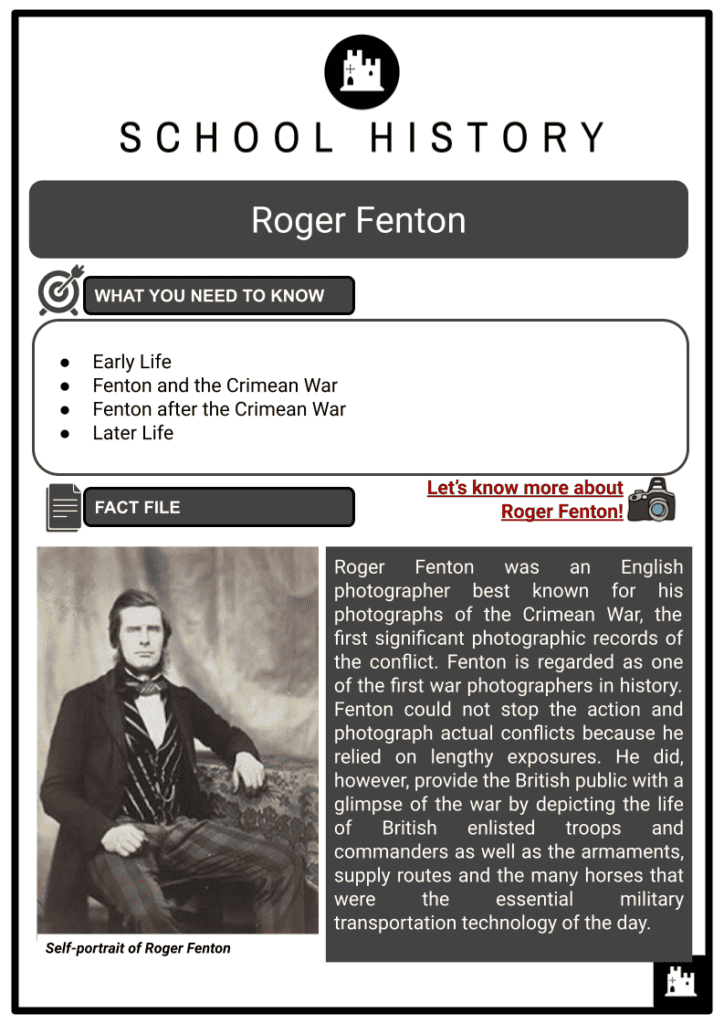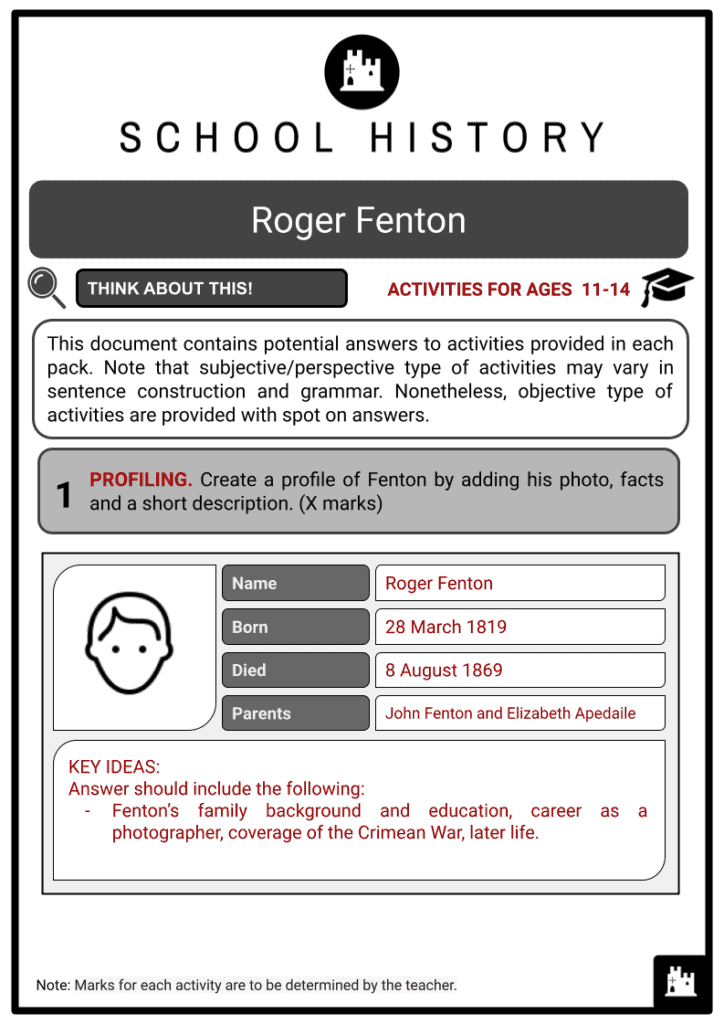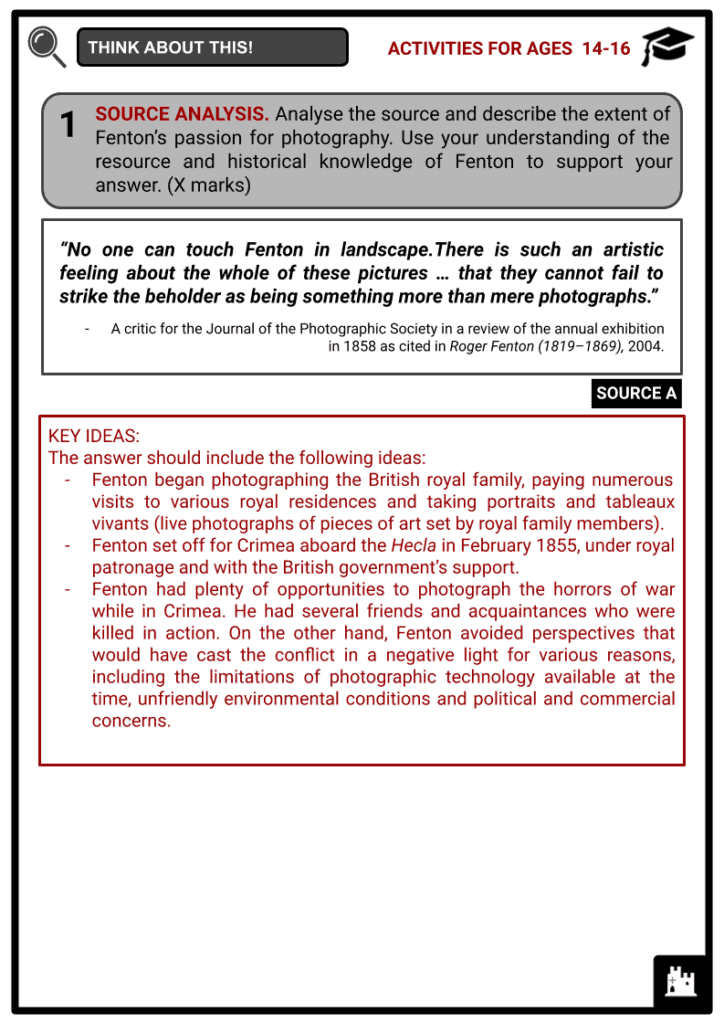Roger Fenton Worksheets
Do you want to save dozens of hours in time? Get your evenings and weekends back? Be able to teach about Roger Fenton to your students?
Our worksheet bundle includes a fact file and printable worksheets and student activities. Perfect for both the classroom and homeschooling!
Summary
- Early Life
- Fenton and the Crimean War
- Fenton after the Crimean War
- Later Life
Key Facts And Information
Let’s know more about Roger Fenton!

Roger Fenton was an English photographer best known for his photographs of the Crimean War, the first significant photographic records of the conflict. Fenton is regarded as one of the first war photographers in history. Fenton could not stop the action and photograph actual conflicts because he relied on lengthy exposures. He did, however, provide the British public with a glimpse of the war by depicting the life of British enlisted troops and commanders as well as the armaments, supply routes and the many horses that were the essential military transportation technology of the day.
EARLY LIFE
- Fenton was born on 28 March 1819 in Crimble Hall, Heywood, Lancashire. His grandfather was a wealthy cotton producer and banker, while his father, John, was a banker and member of parliament from 1832. Fenton was the fourth of his father’s seven children from his first marriage to Elizabeth Apedaile. His father’s second marriage bore him ten additional children.
- Fenton earned a first-class honour’s degree (the highest honour in academia) with a Bachelor of Arts from the University of London in 1840, having studied English, Mathematics, Greek and Latin. He began studying Law at University College London in 1841, apparently irregularly, as he did not qualify as a solicitor until 1847, partially because he became interested in learning to paint.
- Fenton married Grace Elizabeth Maynard in Yorkshire in 1843, possibly following his first visit to Paris, where he may have temporarily studied painting in the school of Paul Delaroche.
- When he enrolled as a copyist at the Louvre in 1844, he described his tutor as Michel Martin Drolling, a historical and portrait painter who worked and taught at the École nationale supérieure des Beaux-Arts. Fenton’s name, however, does not appear in the school records.
- Grace and some of the Fenton children appear in several of Roger Fenton’s photographs, images of which can be found online. Their six children were Josephine Frances, the artist Annie Grace Fenton, Aimée Frances, Eva Katherine, Rose Maynard and Anthony Maynard Fenton. At least three of the children died in infancy.
- Fenton returned to London in 1847, where he continued to study painting under the supervision of history painter Charles Lucy, whom he made friends with and with whom he served on the board of the North London School of Drawing and Modelling beginning in 1850. He showed paintings at the Royal Academy’s annual exhibitions in 1849, 1850 and 1851.
- By 1852, Fenton had images shown in the United Kingdom, had been to Kyiv, Moscow and St Petersburg, and had photographed views and architecture around the United Kingdom (UK).
- His written plea for forming a photographic society was met with the formation of the Photographic Society in 1853, with Fenton as its founder and first Secretary. It later became the Royal Photographic Society (RPS), with Prince Albert of Saxe-Coburg-Gotha as patron.
- The RPS is one of the oldest photographic societies in the world. It was created as the Photographic Society of London in 1853 in London, England, to promote the art and science of photography, and it obtained royal support from Queen Victoria and Prince Albert in 1853.
FENTON AND THE CRIMEAN WAR
- Fenton travelled to Balaklava (in present-day southern Ukraine) to document the Crimean War after being commissioned by a London-based fine arts dealer and print publisher, Thomas Agnew and Sons. He was endorsed by Prince Albert through a letter of introduction to the War Ministry. Because Fenton’s effort was a business venture to create a portfolio of images of combat heroes, his photographs often portrayed a favourable view of the war.

Portrait depicting the French assault on the Malakoff, the main Russian fortification before Sevastopol, on 7 September 1855 during the Crimean War - He photographed the troops’ commanders, such as General Bosquet (1855), and the picturesque and unique people who lived in the region, such as the Group of Croat Chiefs (1855). But he also photographed the soldiers who bore the brunt of the fighting, and their battered faces show the terrible cost of the conflict.
- The Crimean War was fought mostly on the Crimean Peninsula between the British and the Russians, Ottoman Turks and French with backing from the army of Sardinia-Piedmont beginning in January 1855.
- The resulting photographs may have been intended to counteract The Times correspondent William Howard Russell’s occasionally critical reporting and offset the general unpopularity of the war among the British people. The pictures were to be printed as woodblocks in the less critical Illustrated London News.
- Fenton hired Marcus Sparling as his assistant photographer, another assistant named William, and a large horse-drawn carriage full of equipment.

Marcus Sparling, Fenton’s assistant, seated on Fenton’s photographic carriage in Crimea in 1855 - Fenton’s motif options were limited due to the size and weight of his photographic equipment. Because the photographic medium of his day required long exposures, he could only produce photographs of immobile objects, usually posed photographs. He also avoided photographing dead, injured or mutilated soldiers, but his human shots included a woman working as a vivandière. He did, however, shoot the scenery, including a location near the Charge of the Light Brigade, which was immortalised in a poem by Tennyson, an English poet.
- Soldiers had called the original valley The Valley of Death in letters home. Tennyson’s poem used the same phrase, so when Thomas Agnew put the picture on display in a London exhibition in September 1855 as one of 11 photographs collectively titled ‘Panorama of the Plateau of Sebastopol in Eleven Parts’, he assigned photos of soldiers and Tennyson’s description, as the expanded Valley of the Shadow of Death.
FENTON AFTER THE CRIMEAN WAR
- Although his letters and journal demonstrate that he saw enough proof of the war’s horrors, Fenton displayed no scenes of actual death. On one occasion, he discovered the body of a dead Russian and described it as ‘laying as if he had raised himself upon his elbow, the bare cranium standing out with still enough flesh left in the muscles to prevent it dropping from the shoulders’.
- There was no technical reason why Fenton could not have captured this subject. On the other hand, the Crimean War was immensely unpopular with the British public and press, and the government thought that Fenton’s images would counteract bad accusations of military mismanagement.
- Given Fenton’s royal sponsors’ worries and the necessity to make photographs with some commercial potential, it’s not unexpected that he chose not to record the whole horror of battle. Some critics do not believe Fenton to be a legitimate war photographer because he primarily took ‘positive’ photographs of the war.
- Despite the lack of economic success for his Crimean photographs, Fenton afterwards toured extensively around the United Kingdom to capture landscapes and still lives. However, photography became more widely available to the general population as time passed.
- Many people attempted to make money by selling fast portraits to ordinary people. Fenton, who came from a wealthy family, probably despised trade photographers but sought to benefit from the art by taking exclusive photos and selling them at high rates.
- This caused rumours among many of his colleagues who genuinely needed to make money from photography and were willing to sacrifice the quality of their work as Fenton saw it, as well as the Photographic Society, which believed that no photographer should soil himself with the culture of commercially exploiting his talent in any way.
LATER LIFE
- In 1858, Fenton created studio genre pieces, such as Seated Odalisque, based on passionately fanciful views of Muslim life, employing friends and models who were not always convincing.
- Despite being well-known for his Crimean War pictures, Fenton’s career in photography lasted little more than a decade. In 1862, he sold his equipment and left the field entirely, returning to the law as a lawyer.
- In 1862, the organising committee for the International Exhibition in London revealed its intention to exhibit photography among other fine arts rather than beside them, as had been done in the Manchester Art Treasures Exhibition only five years before. Still, for tradespeople, photography was deemed a craft in the division allotted for machinery, tools and instruments.
- On 8 August 1869, he died at the age of 50.
- Art historians later explicitly validated Fenton’s pioneering work and aesthetic endeavour.
- Ninety of Fenton’s photographs were included in a special show devoted to him as the most vital and accomplished 19th-century photographer at the Tate Britain Gallery in London in 2005.
- Fenton was elected to the International Photography Hall of Fame and Museum in 2007.
PHOTOGRAPHS TAKEN BY ROGER FENTON

Image Sources
- https://en.wikipedia.org/wiki/File:Roger_Fenton_self.jpg
- https://en.wikipedia.org/wiki/File:William_Simpson_-_Attack_on_the_Malakoff.jpg
- https://en.wikipedia.org/wiki/File:Roger_Fenton%27s_waggon.jpg
- https://en.wikipedia.org/wiki/File:Roger_Fenton_-_L%27Entente_cordiale_-_Google_Art_Project.jpg
- https://pages.charlotte.edu/visualrhetoric/wp-content/uploads/sites/651/2014/04/3g09353r.jpg
- https://pages.charlotte.edu/visualrhetoric/wp-content/uploads/sites/651/2014/04/3g09322r.jpg
- https://pages.charlotte.edu/visualrhetoric/wp-content/uploads/sites/651/2014/04/3g09222r.jpg
Frequently Asked Questions
- Who is Roger Fenton?
Roger Fenton was a British photographer best known for his pioneering work during the early days of photography. He gained particular fame for his photographs taken during the Crimean War.
- What is Roger Fenton known for?
Roger Fenton is known for his significant contributions to the field of photography. He is especially renowned for documenting the Crimean War through photographs, considered one of the earliest examples of photojournalism.
- What process did Roger Fenton use?
Roger Fenton used the wet collodion process for his photography. This involved coating a glass plate with light-sensitive collodion and silver nitrate, exposing it in a camera, developing it to reveal the image, fixing it to make it permanent, and creating prints from the negative.






